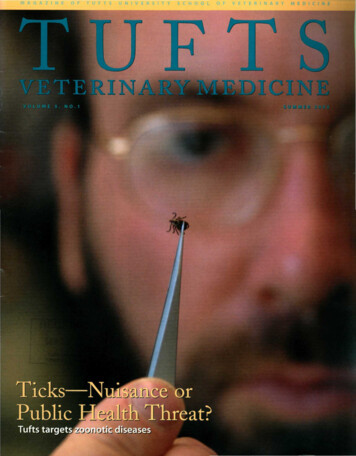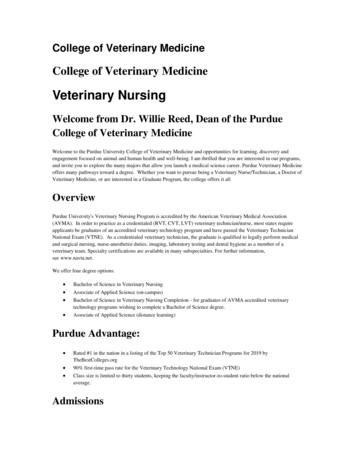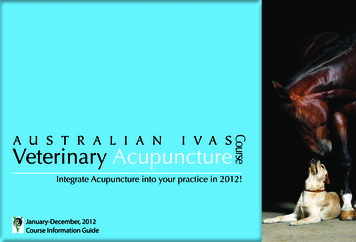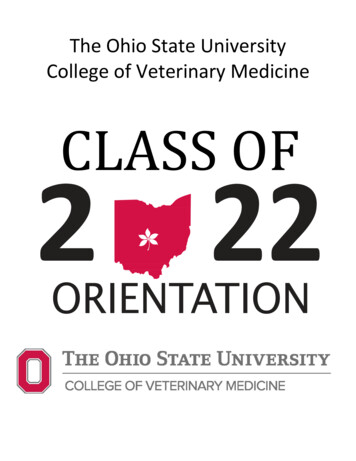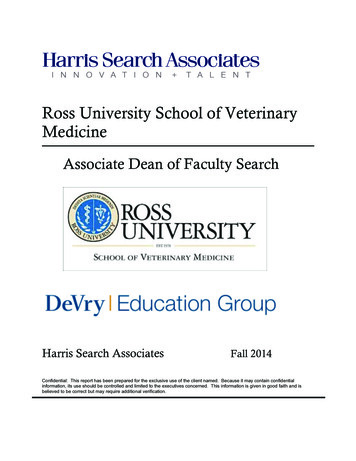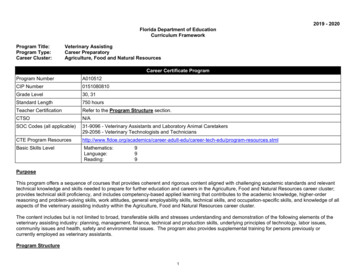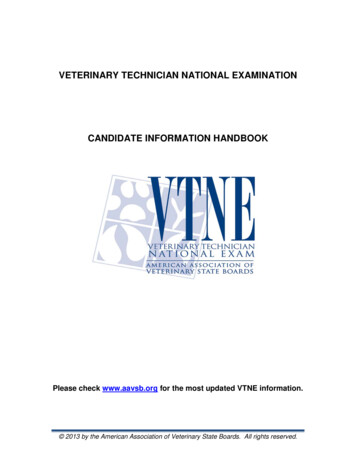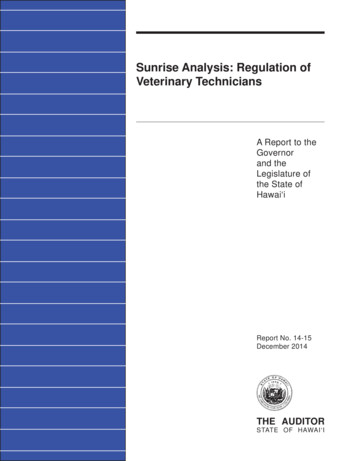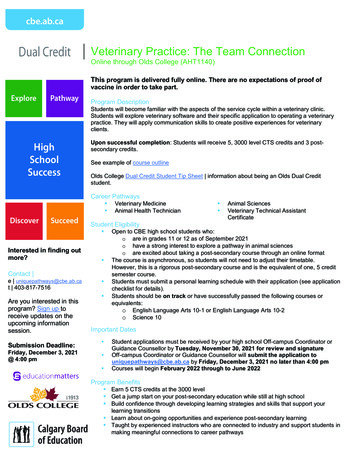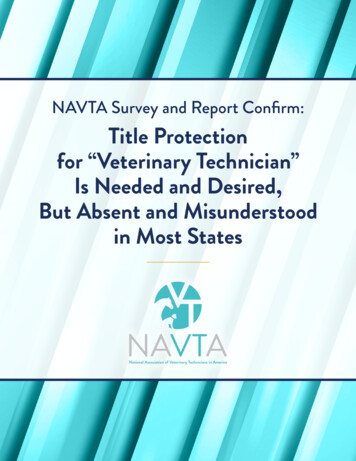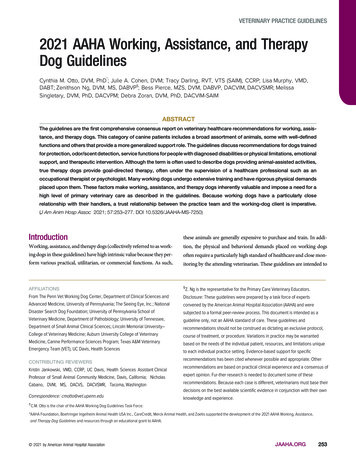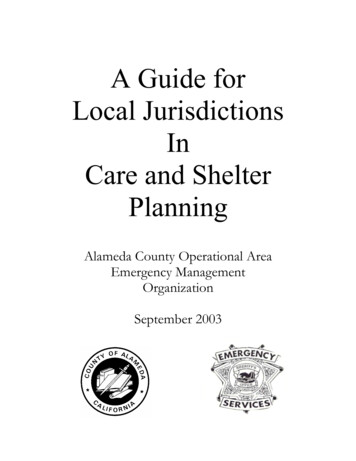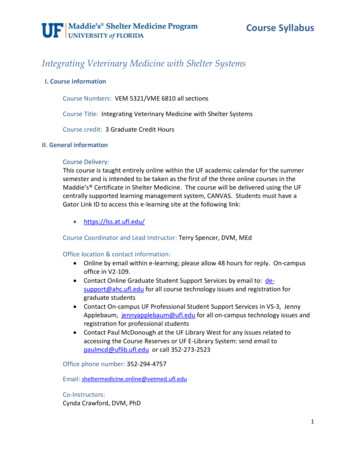
Transcription
Course SyllabusIntegrating Veterinary Medicine with Shelter SystemsI. Course informationCourse Numbers: VEM 5321/VME 6810 all sectionsCourse Title: Integrating Veterinary Medicine with Shelter SystemsCourse credit: 3 Graduate Credit HoursII. General informationCourse Delivery:This course is taught entirely online within the UF academic calendar for the summersemester and is intended to be taken as the first of the three online courses in theMaddie’s Certificate in Shelter Medicine. The course will be delivered using the UFcentrally supported learning management system, CANVAS. Students must have aGator Link ID to access this e-learning site at the following link: https://lss.at.ufl.edu/Course Coordinator and Lead Instructor: Terry Spencer, DVM, MEdOffice location & contact information: Online by email within e-learning; please allow 48 hours for reply. On-campusoffice in V2-109. Contact Online Graduate Student Support Services by email to: desupport@ahc.ufl.edu for all course technology issues and registration forgraduate students Contact On-campus UF Professional Student Support Services in VS-3, JennyApplebaum, jennyapplebaum@ufl.edu for all on-campus technology issues andregistration for professional students Contact Paul McDonough at the UF Library West for any issues related toaccessing the Course Reserves or UF E-Library System: send email topaulmcd@uflib.ufl.edu or call 352-273-2523Office phone number: 352-294-4757Email: s:Cynda Crawford, DVM, PhD1
Course SyllabusBrenda Griffin, DVM, MS, DACVIMJulie Levy, DVM, PhD, DACVIMGuest Speakers, vary by semester based on availabilityLead Teaching Assistant:Lisa Shriver, DVM, Graduate Certificate in Shelter Medicine, Graduate Certificate inVeterinary Forensic Sciences Contact instructors by email within the CANVAS coursePlease allow 48 hours for a responseOffice Hours will be announced and offered via the Adobe Connect webchattool within e-learningWebsite: r-systems/III. Course descriptionCourse goals/Educational goals of the course:Understanding and appreciation of the critical role played by veterinarians in protectingthe health and welfare of sheltered dogs and cats.Course objectives:By the end of this course, students will be able to:1. Use the Association of Shelter Veterinarians (ASV) Guidelines for Standards of Carein Animal Shelters as a guide for the practice of veterinary medicine in a shelterenvironment.2. Use reliable medical information to support best practices within an animalshelter.3. Recognize common infectious diseases, behavioral problems, and examples ofanimal cruelty or neglect presented to animal shelters and describe the shelterveterinarian’s role in responding to such issues.4. Explain the scope of issues related to animal homelessness and interpret recenttrends surrounding those issues.5. Compare and contrast sheltering methods and assess each method for how well itaddresses the “Five Freedoms” of animal welfare.2
Course Syllabus6. Monitor employment opportunities that exist for veterinarians in shelters andcompare the training and experience needed for success in such positions.7. Explain key concepts involved with the practice of Shelter Medicine such as:sanitation, preventive health care, disease outbreak management, behavioralassessments, stress control, population management, cruelty investigations, andhigh-quality/high-volume sterilization and outline plans for addressing each concept.Which objective does each assignment meet?Chapter 2:Dear Shelter DirectorLetterChapter 3: MedicalEvidence AssignmentChapter 4: apter 5:Cat Cam EvidenceAssignmentChapter 6:Analyze One MonthlyData ReportChapter 7:Compare VariousShelter MissionsChapter 8: DiscussCompassion FatigueChapter 8:Locate and CompareJob DescriptionsChapter 9:Discuss Issues,Concerns, andTechniques Involvedwith XXXXXXXXXX3
Course SyllabusSterilizationInfectious DiseaseProjectForensics ProjectBehavior and WelfareProjectXXXXXXXXXXIV. Course MaterialsRequired Texts and Resources:1. Shelter Medicine for Veterinarians and Staff, Second Edition, Lila Miller and StephenZawistowski (editors), Blackwell Publishing, 2013. (NOTE: Available as an e-text in CourseReserves online)2. Infectious Disease Management in Animal Shelters, Kate Hurley and Lila Miller (editors),Wiley-Blackwell Publishing, 2009.3. ASV Guidelines for Standards of Care in Animal SheltersDownload a copy from the Association of Shelter Veterinarians website tandards-oct2011-wforward.pdf4. A desktop or laptop with high-speed internet access and at multiple browsers other thanInternet Explorer (Firefox, Google Chrome, or Safari). Apple iOS and tablets are notcompletely compatible with e-learning at this time. Mobile apps do exist for accessingCanvas, VoiceThread, Adobe Connect, and other distance learning technologies during thecourse. However these mobile applications may have some limitations compared todesktop versions.5. A working headset with microphone to participate in Adobe Connect live chats. A mobileapp is available for Adobe Connect, but it does not have all of the functionality of thedesktop version.6. Students must have Microsoft Office Software installed and have basic skills for usingWord and Excel. Students with a UF GatorLink ID have free access to Lynda.Com fortraining and can download free or greatly discounted software from the UF ComputingHelp Desk (UF Software Services )Recommended Additional Texts: (on-reserve in UF Course Reserves)1. Feline Infectious Diseases, Katrin Hartmann and Julie Levy (editors), MansonPublishing/The Veterinary Press, 2011.2. Infectious Diseases of the Dog and Cat, Fourth Edition, Craig E. Greene, ElsevierHealth, 2011.4
Course Syllabus3. Maddie’s Infection Control Manual for Animal Shelters: for Veterinary Personnel,First Edition, Christine A. Petersen, Glenda Dvorak, and Anna Rovid Spickler(editors), Center for Food Security and Public Health, Iowa State University,2008.4. Veterinary Forensics, Animal Cruelty Investigations, Melinda Merck, Wiley &Sons, 2013. (e-version available)5. BSAVA Manual of Canine and Feline Behavioural Medicine, Debra Horwitz andD.S. Mills, British Small Animal Veterinary Association, 2009.6. Various readings available on UF’s Electronic Reserves, accessible via:https://ares.uflib.ufl.edu and within e-learning Course Reserves area.Technology Requirements1. High-speed internet access, a desktop or laptop computer, and multiple internetbrowsers (Mozilla Firefox, Google Chrome, or Safari). Do NOT use Internet Explorer.Apple iOS and mobile devices (tablets) are not completely compatible with e-learning.UF does offer a mobile app you can access here: http://m.ufl.edu/info/2. A working headset with microphone to participate in optional live chats in AdobeConnect webinar tool.3. Microsoft Office Software installed and basic skills for using Word and Excel. UF onlinestudents are able to download discounted/free software from the UF GatorCloud byvisiting http://www.it.ufl.edu/gatorcloud/ as well as access free training for such toolsLynda.com .V. PrerequisitesStudents should be currently enrolled in a professional veterinary medicine programleading to a DVM or VMD degree and preferably beyond the first year of study; alreadyhold a DVM or VMD degree; or meet the criteria for acceptance to the UF GraduateSchool for the MS in Veterinary Sciences Concentration in Shelter Medicine degreeprogram. Equivalent degree programs from international veterinary medical schools areacceptable.VI. Course OverviewThis course is delivered totally online through UF eLearning using an interactive digital“textbook” divided into chapters. Each chapter includes interactive activities, readings,recordings, webinars, group discussions, and assignments to deepen studentunderstanding as well as assess achievement. Assignments are due throughout thesemester and most assignments allow a three-day window within which work will beaccepted without penalty. Three final projects, assigned early in the semester, are due5
Course Syllabusnear the end of the course and count for the majority of the course grade. Faculty,teaching assistants, and guest specialists are available as resources throughout thecourse.Reading Assignments:The list of required readings by chapter can be found here and on the website here.Most of the readings come from the required textbooks or as files/e-books madeavailable to students within the pages of the Chapters, in the UF Distance LearningLibrary Course Reserves, and on reserve on-campus at the College of VeterinaryMedicine Education Center.Assignments and Grading:Details about each assignment are included within the online Chapters. A list ofassignments and their respective point values can be found here, and on the websitehere.Due DatesDue Dates are provided on a Course Calendar . Students are encouraged to add thisGoogle Calendar to their personal Google Calendar after creating a free Google account.EXTRA CREDIT: Minute Papers, Live Chat Sessions, and/or Case Discussions/Labs/FieldTripsAll students are required to submit three Minute Papers during the semester; more areoptional and worth extra-credit. Ample opportunities exist to earn extra-credit duringthe semester. Live chats in Adobe Connect or field trips to local shelters vary bysemester according to the availability of faculty and guest specialists. See the CourseCalendar for dates and times. Participation in Live Chat sessions is possible even if astudent cannot attend at the scheduled hour by posting questions PRIOR to the session.All sessions are recorded for later viewing by students who cannot attend.Chapter 1: Introduction(Estimated length of chapter, 1 week)Students meet their online classmates; review course structure and expectations; andpractice using the technology of e-learning.Required/Recommended Readings for Chapter 1: (See Reading List)Assignment 1A: Online Orientation Session6
Course SyllabusAssignment 1B: Voice Thread Introductions introduce yourself to your classmates byposting to the All Class Discussion, comment on your classmate’s posts, and PeerReview three of of your colleague’s Voice Thread presentations.Assignment 1C: Quiz Complete a short quiz about the course syllabus, due dates, ande-learning technology used in the course.Assignment 1D: Minute Paper These short papers allow you to reflect on the readingsand assignments of each chapter. You are required to submit three Minute Papers;others are for extra-credit. Upload to Assignments.Chapter 2: Shelter Sleuth: Case of Sick Puppies(Estimated length of chapter, 1 week)Students explore a case-based learning scenario that focuses on infectious diseasescommon to animal shelters. Students use the ASV Guidelines for Standards of Care toprepare a plan of action for use in a shelter to prevent spread of infectious diseases.Students also begin their first of three projects to present in the final chapter.Required/Recommended Readings for Chapter 2: (See Reading List)Assignment 2A: LetterAssignment 2B: Minute Paper Reflect on the readings and assignments in this chapter.Assignment 2C: Infectious Disease Project Selection Select your topic and beginworking on this first of three recorded projects to present later in the semester.Chapter 3: Shelter Sleuth: Case of Embedded Collar(Estimated length of chapter, 1 week)Students explore a case-based learning scenario that focuses on recognizing andresponding to a suspected case of animal cruelty or neglect. Students learn about therole of the veterinarian when examining animals presented as potential victims of acrime and what is expected if they are called to testify as an expert witness during atrial. Students also begin their second of three projects to present in the final chapter.Required/Recommended Readings for Chapter 3: (See Reading List)Assignment 3A: Case QuestionsAssignment 3B: Case Discussion7
Course SyllabusAssignment 3C: Minute Paper Reflect on the readings and assignments in this chapter.Assignment 3D: Forensics Project Selection Select your topic and begin working on thissecond of three recorded projects to present later in the semester.Chapter 4: Shelter Sleuth: Case of Misbehaving Dog(Estimated length of chapter, 1 week)Students investigate a case-based learning scenario that focuses on common behaviorand welfare issues presented to shelters. Students practice assigning Asilomar AccordCategories to such problems; explore how shelters might prevent or modify problembehaviors; and discuss what limitations shelters might have for treating such problems.Students also begin their third of three projects to present in the final chapter.Required/Recommended Readings for Chapter 4: (See Reading List)Assignment 4A: Asilomar AccordsAssignment 4B: Minute Paper Reflect on the readings and assignments in this chapter.Assignment 4C: Behavior & Welfare Project Selection Select your topic and beginworking on this last of three recorded projects to present later in the semester.Chapter 5: Shelter Sleuth: Case of Snotty Cats(Estimated length of chapter, 1 week)Students explore a case-based learning scenario about the influence shelter housing hason adoptions, length-of-stay, and incidence of infectious diseases for cats in animalshelters. Students practice using the Five Freedoms as a benchmark for assessingwhether basic animal welfare needs have been met for sheltered animals. In addition,students investigate options for interventions that can be used to reduce stress withinthe shelter environment.Required/Recommended Readings for Chapter 5: (See Reading List)Assignment 5A: URI DiscussionAssignment 5B: Cat Cam DiscussionAssignment 5C: Low-Stress HandlingAssignment 5D: Housing Assessment8
Course SyllabusAssignment 5E: Minute Paper Reflect on the readings and assignments in this chapter.Chapter 6: Shelter Sleuth: Length-of-Stay(Estimated length of chapter, 1 week)Students explore a case-based learning scenario to discover how data-driven populationmanagement can increase live-release-rates from animal shelters. Students investigatethe importance of standard methods for collecting, analyzing, and reporting data fromshelters. And students investigate how daily monitoring of animal health and welfarecan reduce average length-of-stay in shelters and thereby increase the life-savingcapacity of shelters.Required/Recommended Readings for Chapter 6: (See Reading List)Assignment 6A: Analyze DataAssignment 6B: Capacity for CareAssignment 6C: Minute Paper Reflect on the readings and assignments in this chapter.Chapter 7: Shelter Sleuth: Get to Know a Shelter(Estimated length of chapter, 1 week)Students explore how the mission of a shelter is affected by public perception. Studentsalso investigate how a shelter’s mission influences its capacity for care.Required/Recommended Readings for Chapter 7: (See Reading List)Assignment 7A: Profile a ShelterAssignment 7B: No-Kill NationAssignment 7C: Minute Paper Reflect on the readings and assignments in this chapter.Chapter 8: Shelter Sleuth: The Role of a Shelter Veterinarian(Estimated length of chapter, 1 week)Students explore careers in Shelter Medicine and investigate employmentopportunities. They also explore the professional demands placed on shelterveterinarians and discuss how effective communication, time-management, andprevention of compassion fatigue might decrease stress in this career.9
Course SyllabusRequired/Recommended Readings for Chapter 8: (See Reading List)Assignment 8A: Compassion FatigueAssignment 8B: Stress ManagementAssignment 8C: Job DescriptionAssignment 8D: Minute Paper Reflect on the readings and assignments in this chapter.Chapter 9: Spay Neuter U(Estimated length of chapter, 1 week)Students investigate the role of high-quality/high-volume sterilization surgeries inmodern sheltering and learn about a variety of surgical techniques documented toimprove surgical outcomes. Students consider the controversies surrounding low-costspay/neuter efforts and consider the role of targeted (focused) spay/neuter on reducingintake into animal shelters. Model programs are highlighted. Students also participatein an online journal club to review the mounting evidence about health risks associatedwith sterilization surgeries.Required/Recommended Readings for Chapter 9: (See Reading List)Assignment 9A: Spay/Neuter DiscussionAssignment 9B: Journal Article ReviewAssignment 9C: Minute Paper Reflect on the readings and assignments in this chapter.Chapter 10: Project Presentations and Peer Reviews(Estimated length of chapter, 1 week)Students embed each of their three recorded projects into the Discussions area for theirclassmates to peer-review and instructors to grade. Project owners become theinstructors and reply to all of their classmates’ questions and comments.Required/Recommended Readings for Chapter 10: (See Reading List)Assignment 2D: Infectious Disease Presentation DueAssignment 2E: Infectious Disease Handout DueAssignment 3E: Forensics Presentation Due10
Course SyllabusAssignment 3F: Forensics Case Report DueAssignment 4D: Behavior & Welfare Presentation DueAssignment 4E: Behavior & Welfare Handout DueAssignment 10A: Peer Review five Infectious Disease ProjectsAssignment 10B: Peer Review five Forensics ProjectsAssignment 10C: Peer Review five Behavior & Welfare ProjectsVII. Administrative Policies:For more information on UF Graduate School policies related to grades, attendance,student conduct, and academic honesty please visit the Graduate School .Honesty PolicyAll students registered at the University of Florida have agreed to comply with thefollowing statement: “I understand that the University of Florida expects its students tobe honest in all their academic work. I agree to adhere to this commitment to academichonesty and understand that my failure to comply with this commitment may result indisciplinary action up to and including expulsion from the University.” In addition, on allwork submitted for credit the following pledge is either required or implied: “On myhonor I have neither given nor received unauthorized aid in doing this assignment.”Review the Student Conduct and Honor Code.Plagiarism includes any attempt to take credit for another person’s work. This includesquoting directly from a paper, book, or website, without crediting the source. Sourcesshould be noted, a link to the website added, or quotation marks placed around thematerial and attributed , even during online discussions. However, the instructorexpects more than simply cutting and pasting in this graduate-level course. Studentsare expected to review, evaluate and comment on material they research, rather thansimply copying relevant material. Work will be graded accordingly.Student Evaluation of InstructionEvaluations are performed electronically at the end of the course. To evaluate theinstructor, visit the GatorRater Online Faculty Evaluation site.Accommodations for Students with DisabilitiesStudents requesting accommodations must first register with the Dean of StudentsOffice, Disability Resource Center at 352-392-8565. Students may also apply on-line foraccommodations. For more information, see the Disability Resource Center. The11
Course SyllabusDisability Resource Center will provide a letter to the student who must then meet withthe course instructor to discuss the required accommodations. Once notification iscomplete, the instructor can work with the Disability Resource Center to provide therequested accommodations. To ensure that necessary accommodations are provided ina timely manner, it would expedite this process if any student who might need anaccommodation would notify the course coordinator during registration.Software UseAll faculty, staff and students of the University are required to obey the laws and legalagreements governing software use. Failure to do so can lead to monetary damagesand/or criminal penalties for the individual violator. Because such violations are alsoagainst University policies and rules, disciplinary action will be taken as appropriate.UF Counseling and Wellness CenterMany resources are available for students who need help with stress-related problemsor emergencies. Assistance is available both by appointment and after hours by calling352-392-1575 or visiting the UF Counseling and Wellness Center.Grade ChangesGrades will be changed only when a grading error has been made.Communication with InstructorsThe preferred method for communication between students and the course instructorsand teaching assistants is by Mail within e-learning. Please allow 48 hours for aresponse. Do NOT use the e-learning Discussions board to communicate about gradesor other personal matters.AttendanceLessons within this course can include a combination of asynchronous self-pacedactivities and synchronous activities that require attendance at specific times as detailedon the Course Calendar. Students are expected to visit the eLearning course daily tocheck for important announcements. Instructors monitor participation in discussionboards and other activities within the eLearning management system.Class ParticipationStudents are expected to constructively and professionally participate in onlinediscussions and while completing both individual and group projects. Students are alsoexpected to contribute interesting and relevant information during the discussions,chats, and group projects. All interactions between classmates and/or faculty must bepolite and professionally conducted. Shouting (using all capital letters), use of profanityor insulting language, or plagiarism will not be permitted. However, avoid clogging the12
Course Syllabusdiscussion boards with short responses such as, “Good Job” or “Thanks” or “Me Too” assuch postings contribute little to the discussion.Performance ExpectationsSuccessful students report they spend between 6 to 10 hours working on courseactivities each week. Students are expected to produce quality work of a standardcomparable to any graduate-level didactic course. Postings, assignment submissions,and discussions must be legible, constructive and appropriate. Students are required tothink for themselves and will be expected to complete assignments that require theapplication of logic and reasoning skills when the answer may not be found in a book orthe course notes. Factual information should be documented and referenced duringdiscussions and within assignments.Make-Up Work, Late Assignments, and Due DatesStudents are expected to complete assignments according to the due dates posted onthe course calendar within eLearning. In most cases, due dates include a flexible 72hour window in which to submit work. On occasion, students might request anextension in ADVANCE of a due date. However, once a due date is passed, late workwill be graded at 50% of point value.If a student experiences a technical problem they should immediately notify desupport@ahc.ufl.edu. If such an issue prevents a student from submitting an assignmentby the due date, the student will be expected to produce a help desk ticket to documentefforts were made to correct the problem in a timely manner prior to the due date.Important Dates/Deadlines to WithdrawConsult the UF Academic Calendar for details on key dates for dropping or withdrawingfrom this course and any tuition penalties that apply. Consult the Course Calendarwithin e-learning for important dates and deadlines that pertain to this course.13
Word and Excel. Students with a UF GatorLink ID have free access to Lynda.Com for training and can download free or greatly discounted software from the UF Computing Help Desk (UF Software Services ) Recommended Additional Texts: (on-reserve in UF Course Reserves) 1. Feline Infectious Diseases, Katrin Hartmann and Julie Levy (editors), Manson
